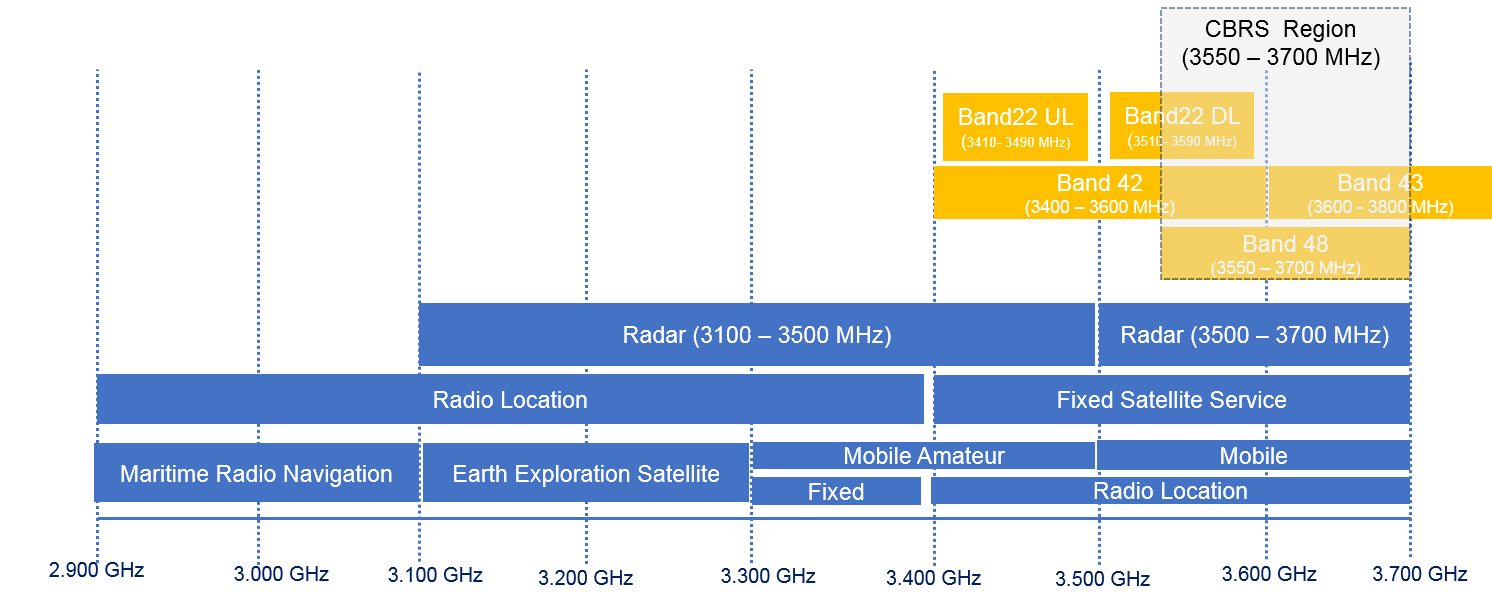RSRP (Reference Signal Received Power)
Reference Signal Received Power
RSRP is the linear average of reference signal power (in Watts) measured over a specified bandwidth (in number of REs). This is the most important measurement UE has to do for cell selection, re-selection and handover. It is very similar to CPICH RSCP in WCDMA. It is applicable while UE in different RRC states i.e. RRC_IDLE intra-frequency, RRC_IDLE inter-frequency, RRC_CONNECTED intra-frequency, RRC_CONNECTED inter-frequency
3GPP definition of RSRP in 36.214 specification is as :
Reference signal received power (RSRP), is defined as the linear average over the power contributions of the resource elements that carry cell-specific reference signals within the considered measurement frequency bandwidth. For RSRP determination the cell-specific reference signals R0 according TS 36.211 shall be used. If the UE can reliably detect that R1 is available it may use R1 in addition to R0 to determine RSRP. R0 is the Cell Specific Reference Signal for Antenna Port 0 and R1 is the Cell Specific Reference signal for Antenna Port 1
This measures only the reference power, we can say this is the strength of the wanted signal, but it does not gives any information about signal quality. RSRP gives us the signal strength of the desired signal and UE usually measures RSRP based on the direction (RRC message) from the eNodeB and report the value. It sends a non-negative value ranging from 0 to 97 and each of these values are mapped to a specific range of real RSRP value defined in 3GPP 36.133 specifications and given in below Table.
| Reported RSRP (Integer) | From RSRP Value (dBm) | To RSRP Value (dBm) |
|---|---|---|
| 00 | – 140 dBm | |
| 01 | – 140 dBm | – 139 dBm |
| 02 | – 139 dBm | – 138 dBm |
| 03 | – 138 dBm | – 137 dBm |
| 04 | – 137 dBm | – 136 dBm |
| 05 | – 136 dBm | – 135 dBm |
| 06 | -135 dBm | – 134 dBm |
| 07 | – 134 dBm | – 133 dBm |
| 08 | – 133 dBm | – 132 dBm |
| 09 | – 132 dBm | – 131 dBm |
| 10 | – 131 dBm | – 130 dBm |
| 11 | – 130 dBm | – 129 dBm |
| 12 | – 129 dBm | – 128 dBm |
| 13 | – 128 dBm | – 127 dBm |
| 14 | – 127 dBm | – 126 dBm |
| 15 | – 126 dBm | – 125 dBm |
| 16 | – 125 dBm | – 124 dBm |
| 17 | – 124 dBm | – 123 dBm |
| 18 | – 123 dBm | – 122 dBm |
| 19 | – 122 dBm | – 121 dBm |
| 20 | – 121 dBm | – 120 dBm |
| 21 | – 120 dBm | – 119 dBm |
| 22 | – 119 dBm | – 118 dBm |
| 23 | – 118 dBm | – 117 dBm |
| 23 | – 117 dBm | – 116 dBm |
| 25 | – 116 dBm | – 115 dBm |
| 26 | – 115 dBm | – 114 dBm |
| 27 | – 114 dBm | – 113 dBm |
| 28 | – 113 dBm | – 113 dBm |
| 29 | – 112 dBm | – 111 dBm |
| 30 | – 111 dBm | – 110 dBm |
| 31 | – 110 dBm | – 109 dBm |
| 32 | – 109 dBm | – 108 dBm |
| 33 | – 108 dBm | – 107 dBm |
| 34 | – 107 dBm | – 106 dBm |
| 35 | – 106 dBm | – 105 dBm |
| 36 | – 105 dBm | – 104 dBm |
| 37 | – 104 dBm | – 103 dBm |
| 38 | – 103 dBm | – 102 dBm |
| 39 | – 102 dBm | – 101 dBm |
| 40 | – 101 dBm | – 100 dBm |
| 41 | – 100 dBm | – 99 dBm |
| 42 | – 99 dBm | – 98 dBm |
| 43 | – 98 dBm | – 97 dBm |
| 44 | – 97 dBm | – 96 dBm |
| 45 | – 96 dBm | – 95 dBm |
| 46 | – 95 dBm | – 94 dBm |
| 47 | – 94 dBm | – 93 dBm |
| 48 | – 93 dBm | – 92 dBm |
| 49 | – 92 dBm | – 91 dBm |
| 50 | – 91 dBm | – 90 dBm |
| 51 | – 90 dBm | – 89 dBm |
| 52 | – 89 dBm | – 88 dBm |
| 53 | – 88 dBm | – 87 dBm |
| 54 | – 87 dBm | – 86 dBm |
| 55 | – 86 dBm | – 85 dBm |
| 56 | – 85 dBm | – 84 dBm |
| 57 | – 84 dBm | – 83 dBm |
| 58 | – 83 dBm | – 82 dBm |
| 59 | – 82 dBm | – 81 dBm |
| 60 | – 81 dBm | – 80 dBm |
| 61 | – 80 dBm | – 79 dBm |
| 62 | – 79 dBm | – 78 dBm |
| 63 | – 78 dBm | – 77 dBm |
| 64 | – 77 dBm | – 76 dBm |
| 65 | – 76 dBm | – 75 dBm |
| 66 | – 75 dBm | – 74 dBm |
| 67 | – 74 dBm | – 73 dBm |
| 68 | – 73 dBm | – 72 dBm |
| 69 | – 72 dBm | – 71 dBm |
| 70 | – 71 dBm | – 70 dBm |
| 71 | – 70 dBm | – 69 dBm |
| 72 | – 69 dBm | – 68 dBm |
| 73 | – 68 dBm | – 67 dBm |
| 74 | – 67 dBm | – 66 dBm |
| 75 | – 66 dBm | – 65 dBm |
| 76 | – 65 dBm | – 64 dBm |
| 77 | – 64 dBm | – 63 dBm |
| 78 | – 63 dBm | – 62 dBm |
| 79 | – 62 dBm | – 61 dBm |
| 80 | – 61 dBm | – 60 dBm |
| 81 | – 60 dBm | – 59 dBm |
| 82 | – 59 dBm | – 58 dBm |
| 83 | – 58 dBm | – 59 dBm |
| 84 | – 57 dBm | – 59 dBm |
| 85 | – 56 dBm | – 55 dBm |
| 86 | – 55 dBm | – 54 dBm |
| 87 | – 54 dBm | – 53 dBm |
| 88 | – 53 dBm | – 52 dBm |
| 89 | – 52 dBm | – 51 dBm |
| 90 | – 51 dBm | – 50 dBm |
| 91 | – 50 dBm | – 49 dBm |
| 92 | – 49 dBm | – 48 dBm |
| 93 | – 48 dBm | – 47 dBm |
| 94 | – 47 dBm | – 46 dBm |
| 95 | – 46 dBm | – 45 dBm |
| 96 | – 45 dBm | – 44 dBm |
| 97 | – 44 dBm |
Practical Example of RSRP:
Let’s consider a single atnenna system and say the Reference Signal Transmitted power is about 12 dBm. A UE is located somewhere in the cell experiencing a path loss of 100 dB. Then the RSRP measured by UE should be 12-100 = -88 dBm , When we compare -88dBm value in then table it is corresponding to RSRP Integer value 52 so UE can report RSRP=52 in the measurement report.
Normally, when anyone see the UE logs measurement report ,it contained the RSRP integer value, the quick way to find our absolute RSRP value in dBm is simply subtract the integer value from -140 .Let’s take an example Integer RSRP value is 45 then corresponding RSRP dBm = -140 + 45 = -95 dBm.
Submitted By
Sukhvinder Malik



